What are Model Categories? (Homotopy Theories pt 1/4)
11 Jul 2022 - Tags: homotopy-theories
I’m a TA at the HoTTEST Summer 2022, a summer school about
Homotopy Type Theory, and while I feel quite comfortable with the
basics of HoTT, there’s a ton of things that I should really know
better, so I’ve been doing a lot of reading to prepare. One thing
that I didn’t know anything about was
This was originally going to be one post, but it ended up having
a lot of tangentially related stuff all mashed together, and it
felt very disorganized and unfocused1. So I’ve decided to split it
into three four posts, with each post introducing a new, more abstract
option, and hopefully saying how it solves problems present in
the more concrete settings.
Let’s get to it!
First of all, what even is a “homotopy theory”? Let’s look at the primordial example:
Whatever a “Homotopy Theory” is, it should encompass the category
But there’s another motivating example, which we also call “homotopy”:
Whatever a “Homotopy Theory” is, it should encompass the chains of modules, where we identify two chains up to quasi-isomorphism
Obviously these are related – after all, from a topological space we can
get an associated “singular cochain” of
More abstractly, what links these situations? Well, we have some objects that we want to consider “the same up to homotopy”, and we capture this (as the category inclined are liable to do) by picking out some special arrows. These are the “homotopy equivalences” – and they’re maps that we want to think of as isomorphisms… but which might not actually be.
So, in
With these examples in mind, what should a homotopy theory be?
A Relative Category is a small3 category
Following our examples, we want to think of the arrows in
Now, a (small) category is an algebraic structure. It’s just a set
with some operations defined on it, and axioms those operations satisfy.
So there’s nothing stopping us from just… adding in new arrows,
plus relations saying that they’re inverses for
the arrows we wanted to be isomorphisms. By analogy with ring theory,
we call this new category the Localization
For example, if we localize
Tentatively, then, we’ll say that a homotopy theory is a category of the
form
Notice that the choice of
In this situation we say that
There are many important examples of two relative categories
presenting the same homotopy theory. To start, let’s consider the
category
This means that if we have a question about topological spaces up to homotopy, we can study simplicial sets instead, with no loss of information! This is fantastic, since simplicial sets are purely combinatorial objects, so (in addition to other benefits) it’s much easier to tell a computer how to work with them7!
This is great, but there’s one hitch…
The homotopy category
This is all basically because arrows in
where all the
There’s a zoo of techniques for working with homotopy categories, but
they all come down to trying to tame this unwieldy definition of arrow9.
In this post, we’ll be focusing on a very flexible approach by endowing
Roughly, to put a model structure on
From these, we define some “nice” classes of objects:
Let’s see some examples:
A fibration
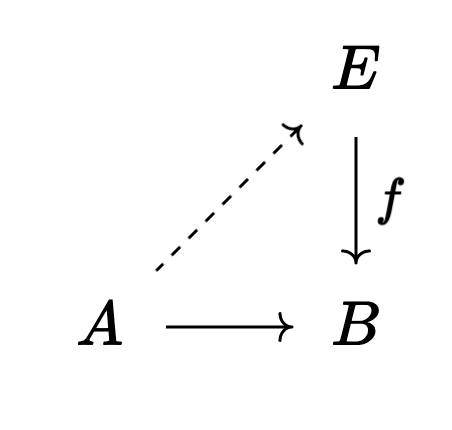
For instance, covering spaces and bundles are examples of fibrations in topology. If we restrict attention to the CW-complexes then every object is cofibrant, and this statement is basically the homotopy lifting property for covering spaces.
Algebraically, there’s a model structure where a map of chains of
Dually, a cofibration
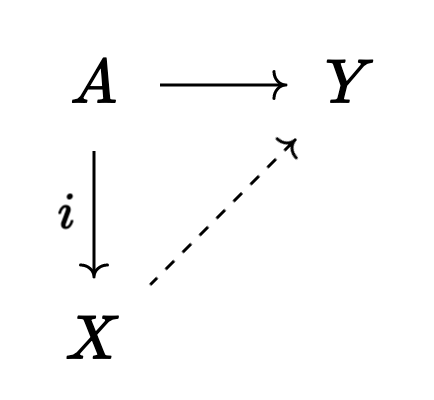
We should think of a cofibration as being a subspace inclusion
For instance, the inclusion arrow of a “good pair” is a cofibration. Thus
inclusion maps of subcomplexes of a simplicial/CW/etc. complex are cofibrations.
More generally, any subspace inclusion
Algebraically, a map
Precisely, these triangles are really special cases of squares. In the
fibration case, the left side of the square is the unique map from the
initial object to
This lets us unify these diagrams into a single axiom, which says that a square of the form
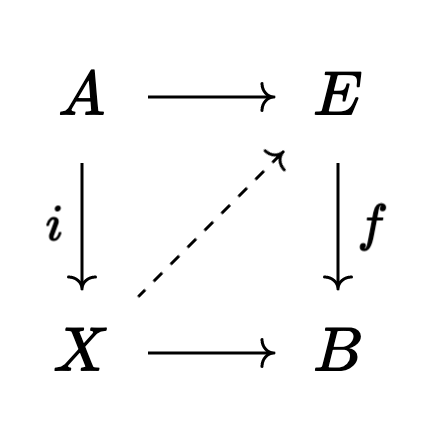
has a lift (the dotted map
The model category axioms11 imply that every object is weakly equivalent to a bifibrant object. Since, after localizing, our weak equivalences become isomorphisms, this means we can restrict attention to the bifibrant objects… But why bother?
Well in any model category we have a notion of “homotopy” between maps
Precisely, each object
⚠ This is not in general an actual product with some element
The best notation is probably
Now if
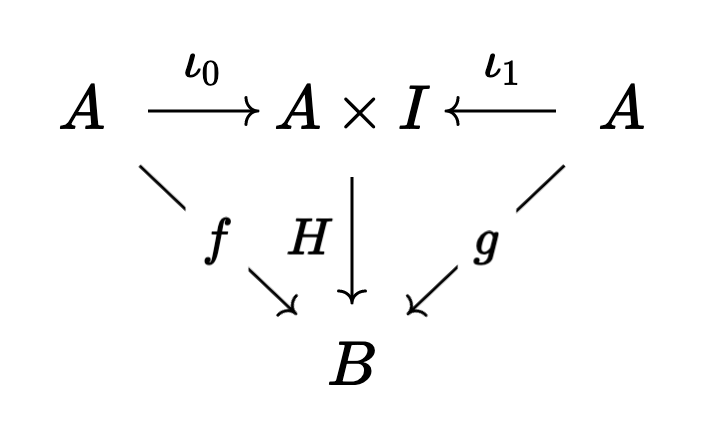
If there is a homotopy between
This brings us to the big punchline:
Let
-
If
-
Thus, a very common way we use model structures to perform computations is by
first replacing the objects we want to compute with by weakly equivalent
bifibrant ones. For instance, we might replace a module by a projective
resolution13. Then maps in the homotopy category
Notice this, off the bat, solves one of the problems with homotopy categories.
Maybe
Moreover, model structures give us a very flexible way to tell when two
relative categories have the same homotopy theory. Indeed, say we we have
a pair of adjoint functors
This is called a Quillen Equivalence between
Moreover again, even if
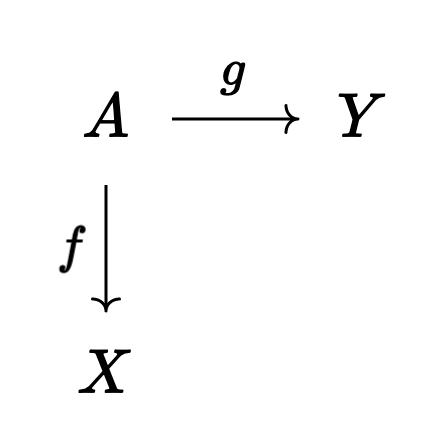
will be the colimit of the related diagram:
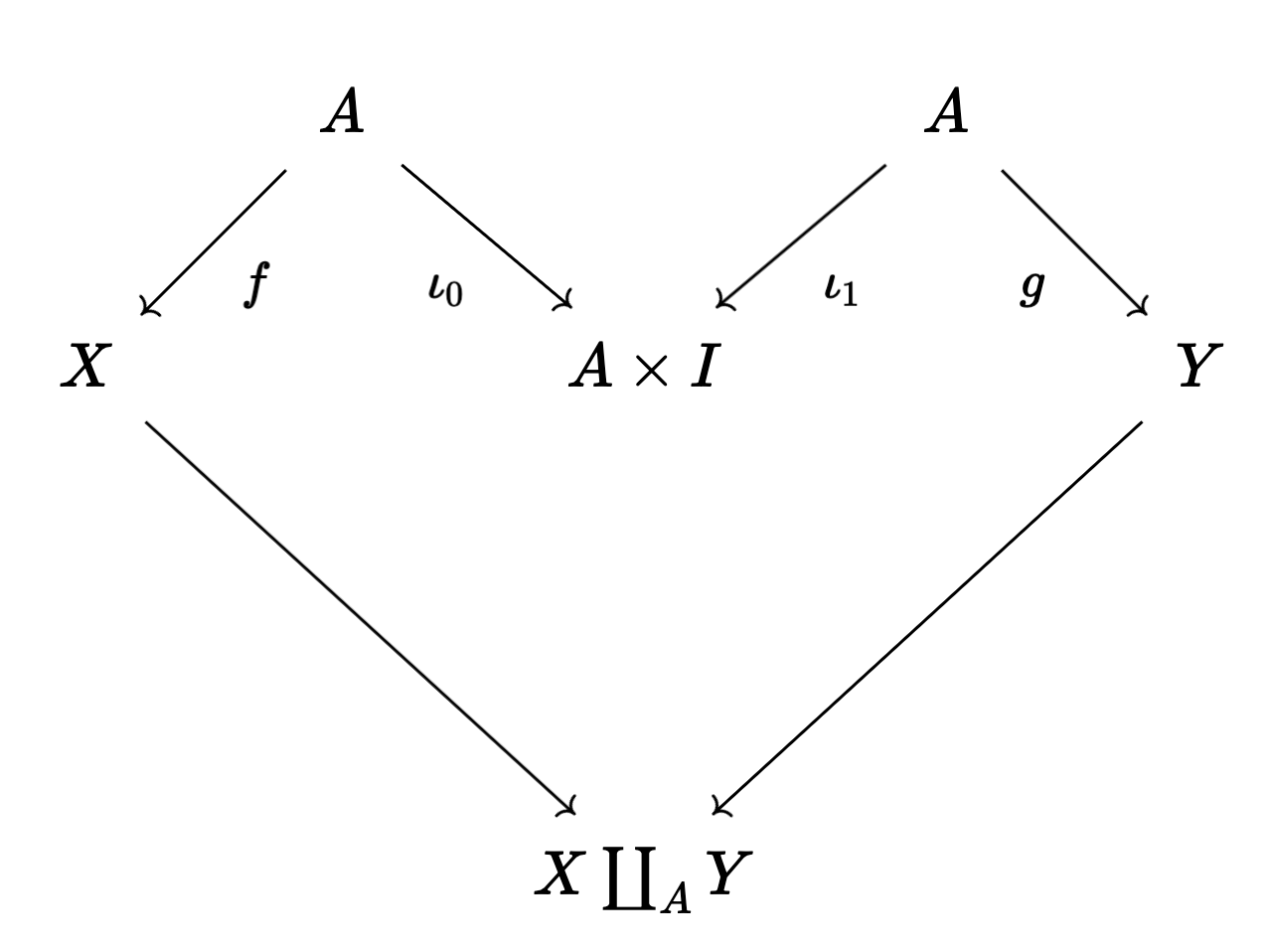
Geometrically, rather than gluing
Something like this will always work, but knowing how to modify our diagram (and why) can be quite involved16. Thus we’ve succeeded in computationally solving the (co)limit issue, but it would be nice to have a more conceptual framework, in which it’s obvious why this is the “right thing to do”…
We’ve seen that a model structure on a relative category helps to make
computations in the localized category
For one, there’s no great notion of a
functor between model categories. In the case that a functor
Related to functors, if
With this in mind, we would like to have a version of the theory of model categories which has better “formal properties”. While working with a single model category is often quite easy to do, as soon as one looks for relationships between model categories, we’re frequently out of luck. In fact, since (co)limits come from functors, as soon as we’re interested in (co)limits we already run into this problem! This is one philosophical reason for the complexity of homotopy (co)limits.
The solution lies upwards, in the land of
How exactly does this work? You’ll have to read more in part 2!
-
This is one of the biggest problems with trying to explain things you know. Especially while you’re still trying to sort them out yourself!
All of this material was scattered in my head with messy interconnections, but of course words have to be linearly ordered on a page, and it took a lot of work to figure out how to put these ideas into a fixed order. Especially one which has a nice narrative.
It’s currently my fifth time restarting this post (now
trilogytetralogy), but I think I’m finally happy with my outline. I don’t know why I’m writing this footnote, to be honest. But it felt like something I wanted to say, so here we are.On with the show! ↩
-
It turns out there’s also a model category structure whose homotopy category gives homotopy equivalence, rather than weak homotopy equivalence.
But the model structure on
-
A better word would probably be “strict”. Since we’re going to be treating
-
Be careful, though, I’ve seen a handful of other definitions too!
I like this one because it means the obvious way to turn a category into a relative category is to take just the isomorphisms. Then localization from
I’m not sure if I should require that
-
This was a pleasant surprise for me. I’ve heard a lot of talk about derived categories, and they always seemed quite scary. It’s been very exciting to feel like I’m getting a two-for-one deal every time I notice another concept in this subject start to make sense – after all, it means I’m learning about both homotopy theories and derived categories! ^_^ ↩
-
As an aside, as a topos theorist, this all feels a bit familiar.
Just like a model structure (which we’ll define later) is some structure that presents a homotopy theory in a way that lets us do concrete computation, a site is a structure that presents a (grothendieck) topos and lets us do concrete computations.
Now, in the topos theory world, Olivia Caramello’s bridges program is based on the idea that we can find nontrivial relationships between two sites presenting the same topos… I wonder if there are any theorems that let us relate two model categories presenting the same homotopy theory. ↩
-
Even in the case of
-
For instance you can only look at families
and these are quite easy to manipulate.
See Sasha Polishchuk’s lectures on Derived Categories here, for a really nice treatment using this language. ↩
-
Really we’re describing the projective model structure here. There’s a dual model structure with the same weak equivalences where we work with injectives instead. ↩
-
Which I still haven’t really told you, haha.
I don’t want to get into the precise details of a model structure here, but you can (and should!) read more in Dwyer and Spalinski’s excellent introduction Homotopy Theory and Model Categories, available here, for instance.
There’s a lot of good places to get intuition for model structures as well.
For instance, Mazel-Gee’s The Zen of
While we’re at it, there’s also Goerss and Schemmerhorn’s Model Categories and Simplicial Methods (here), Hovey’s book (here), and you can find a lot of good intuition in the MO questions here, here, here, and here. There’s also Ponto and May’s More Concise Algebraic Topology (here)… I could keep going, but I should probably get back to writing the main body of the post. ↩
-
We build
where
-
This is made even more useful by the existence of multiple model structures on
-
For an example of this idea in action, see this answer of mine. ↩
-
For example, the earlier example of
In fact, quillen equivalence is stronger tronger way than we currently have the language to describe. Not only are the localizations (read: homotopy categories) equivalent, but actually the presented
-
Even though it’s complicated, this is a solved problem. We understand how to take a diagram and massage it into a new, “homotopy coherent” diagram. The idea is again one of bifibrant replacement!
In many cases we can put a model structure on the category of functors into a model category
See either the notes by Dugger here or by Hirschhorn here for specifics.
Also, after reading those, notice that already the best way to organize this data is with some kind of simplicial object… and keep a pin in that. ↩
-
Though, thankfully, most model categories that arise in practice are (quillen equivalent to) a (simplicial) combinatorial model category.
In particular, this means that we can usually put a model structure on the category of diagram in
This is basically the derived functor approach to homotopy (co)limits, and while it’s effective, it requires us to choose a bifibrant replacement. Much like choosing coordinates or a basis makes some proofs more annoying in the setting of differential geometry or linear algebra (since we then have to prove our results are independent of this choice), we would like to have a choice-free way of defining homotopy (co)limits. ↩
-
In fact, it eats its own tail, and we have an